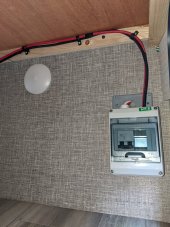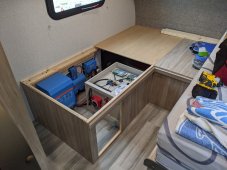a bit lightweight when it comes to insulation. Walls are only about 1.25" thick, vs. the 2" thick walls of other rigs.
Is that foam? Or fiberglass blanket?
And of course, single pane windows get tons of condensation
In a number of aspects reflectix is marketing hype, but it is useful if one is a) mindful of how heat/cold works and b) willing to accept you won’t get miraculous biblical performance out of it.
For the purposes of putting money in the bank I “downsized” to a ~25’ camper for three summers. This past summer- my 4th- I planned to get an apartment for the winter as usual but when when I was about to drop $3500 for an apartment I balked when I considered how long it takes to accumulate money. I decided to try using it all winter and it was successful. No moisture issues. And I’m in Vermont.
Three of the things I did to winterize are easily done and you could accomplish without major “renovations” to your camper.
1) I bought plexiglass and made “storm panels” for the window interiors. With self-adhesive foam weatherstrip around the perimeters and #6 screws with finishing washers through predrilled holes this stopped air movement in wind and was a noticeable heating improvement (did it November)
2) I made reflectix covers over the storm panels and attached with push-pins. I was skeptical but it had made a dramatic difference in the bathroom and over the two roof vent openings. I got a big roll and covered the windows and that was also a noticeable improvement.
3) I lined the closet, cubbies and the cabinets with 1/2” foil faced foam. Again I was surprised at the improvement though it was less felt than I noticed the furnace duty cycle was less.
Less easily done and requires some commitment and dollars: the 1978 Dutch Craft has somewhat high ceilings which I padded down 1-1/2” with 2x2s from HD glued and screwed and insulated with foam. 3/16 plywood, and glued inexpensive carpet to the ceiling. I also pulled the paneling in front and fit 2” of foam with every piece perimeter sealed with spray foam. I had previously removed the propane fridge and installed a 120V fridge- when I did that I removed ‘venting’ and insulated the wall and ceiling opening well (From the factory it has 4” of fiberglass in the floors with aluminum underbelly which I left because retrofit of floors is major construction)
My water didn’t freeze even with the -28*F night we had. I did pour some salt in the drains after showering or using the kitchen sink. The shower drain had ‘thick’ water a couple times but the 100* shower water always cleared it out. No ice.
Condensation wasn’t an issue. I opened the roof vent above when I showered every morning which depending on the wind was…invigorating. That’s how I did it.
. I can really see where the aluminum structure members are in the walls from the water beading up extra heavy there.
This takes commitment. 1-1/2” of foam with 1x2 “furring” offset from factory ‘studs’ and new plywood paneling, window trim, extended crank handles, electrical wiring awareness, and adjustment of cabinets. Adjustment of cabinets has to be carefully thought out because they are usually a structural component of any camper.




